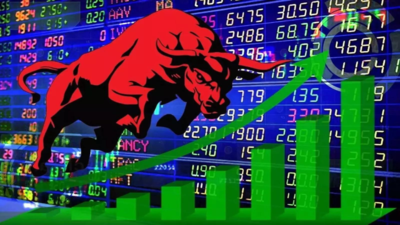What’s fuelling India’s next market leap? Sensex could hit 3 lakh by 2035, says Raamdeo Agrawal as compounding powers return

As domestic money cushions corrections, veteran sees index doubling twice; points to compounding, macro strength and rising retail depth.The Indian equity market’s surprising ability to recover from every correction is no accident, says veteran investor Raamdeo Agrawal, who attributes the trend to the sustained flow of domestic capital. This resilience, he believes, will underpin a powerful compounding journey that takes the Sensex to 1.5 lakh by 2030 and 3 lakh by 2035.“We are getting whatever $50 to $100 billion flows continuously. So whatever you sell, there is support,” said Agrawal, Chairman and Co-founder of Motilal Oswal Financial Services. “It (inflows) does not allow it (market) to go down too much.”In an interview with ET Markets, Agrawal drew on four decades of historical data to justify his projection. “If you look at the last 45 years of history, the market has grown at a CAGR of 15%, which means double every five years. So now it is 80,000, I will say 1.5 lakh in five years. I am keeping 10,000 in my pocket (just to be safe). In 2030, it will be 1.5 lakh and in 2035, it will be 3 lakh.”Recalling the early days of his investing journey, he said, “When I bought my first stock in 1980, Sensex was at 100. And now it is at 80,000. So it is up 800 times at a CAGR of 16%. That’s the history.”Some may question whether the index can continue doubling at higher base levels, but Agrawal argues the global backdrop supports such growth. “See the world economy, which was, let’s say, $25 trillion in 1995, is about $115 trillion now. The world is growing at 5%, and even gold will double in 15 years. The economy will grow to $250 trillion in 2040. In that incremental growth, we will get around $10 trillion in the next 25 years.”Agrawal urges investors to build a forward-looking mindset. “While picking stocks, you will have to look at 2035. You will not be able to recognise the market in 2035. It is going to become so big.”He pointed to Reliance Industries as a striking case of long-term compounding. “Reliance was a Rs 20,000 crore company in 2003–04. Today, it is a Rs 20 lakh crore company. That’s compounding which allows you to see the future approximately. That’s 99%, but a lot can happen in that remaining 1%.”“Half the time, the future will be better than what you are thinking. Half the time, it will be worse. Your job is to figure out that you end up being on the right side most of the time.”Agrawal outlined four big investment themes for the next decade:
- Quick commerce: He believes this segment could unlock a $1 trillion opportunity. “Quick commerce is taking India by storm as everyone wants groceries and all other products home delivered. Who wants to carry a bag to buy stuff?” He estimates that $700–800 billion of that market value may be addressed despite catering to just 20% of the population.
- Capital markets boom: The financialization of savings is driving participation. “There is a boom in capital markets,” he said, pointing to buzz around a possible NSE IPO. “It can be big as it is the mother of all capital market entities.”
- Energy transition: Solar and wind energy, once distressed sectors, have turned around dramatically. “They were once in bankruptcy stage and look at them now!”
- Manufacturing: Agrawal sees a nationwide shift as states woo industry. “This is a trend which started from Gujarat and now it is all over the country.”
Still, he advised caution: “These are tail-winded industries. Just because there is a tailwind, you cannot make money. You have to buy it at the right price.”On market structure, Agrawal said promoters hold about 50%, foreign institutional investors 17%, and the rest lies with domestic institutions and retail investors. “FIIs have options—they can go to Korea, China, Russia. So, they are net sellers marginally. These [domestic] guys are continuous buyers.”He said this trend reflects a maturing market. “As you become a developed country, it happens. By 2047, promoters will be as low as 5–10%.”Looking at India’s broader journey, Agrawal said, “At that time our economy was very weak. About 97% of people were below the poverty line and now only 20–30% people are below the poverty line. Today we are self-dependent on food and forex.”He added, “Just imagine if you are a poor man and your son has qualified to become a CA. What will he do now? We will beat the world. There is no corporation (globally) where there are no Indians.”Despite all uncertainties, he remains convinced: “Overall the market will keep growing at that 15%. I still see the index doubling in the next five years.”





